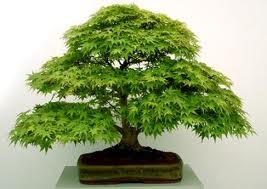 Bonsai, as a Japanese art kind, is more regulated than it’s Chinese counterpart, the penjing. Bonsai attempts to accomplish the ideal tree, while penjing attempts to reproduce nature. This really is why perfect styling exists in bonsai if you obey the ‘rules’, while penjing leave you totally free for your creation. Being a result these are the fundamental styles :
Bonsai, as a Japanese art kind, is more regulated than it’s Chinese counterpart, the penjing. Bonsai attempts to accomplish the ideal tree, while penjing attempts to reproduce nature. This really is why perfect styling exists in bonsai if you obey the ‘rules’, while penjing leave you totally free for your creation. Being a result these are the fundamental styles :
Broom (Hokidachi or Hoki-zukuri)
A extremely harmonious style, this type has branches that produce at a certain height, forming an upside broom. This styling is mainly accomplished via a approach called the “V†cut. The trunk is chopped where you want the branch to start to develop and then a deep V cut is performed on the remaining trunk. This will induce buds to break near the cut. Zelkova serrata are notorious for this styling but maple and other deciduous species can very easily be styled that way.
Formal Upright (Chokkan)
A tree styled the “chokkan†way has a straight trunk tapering graciously from bottom to top. The initial and biggest branch is generally situated at 1/3 of the desired height from the tree and is around the correct or the left. The following branch is situated on the opposite side, while the third is inside the back making the perception depth. As we appear at the branch structure from bottom to best, the branches are acquiring thinner, making a pyramidal shape.
Informal Upright (Moyogi)
This model is extremely related for the previously mentionned model since the same guidelines of design apply, nevertheless, the trunk isn’t straight but rather forms a sinuous form whilst remaining tapered. This model is commonly utilized with conifers.
Slanting (Shakan)
As soon as again, this style could be the same since the formal upright except that the trunk is leaning on 1 aspect. Branches are grown uniformly about the trunk like the formal/informal upright types but the apex is tilted for the opposite part with the trunk giving a visual balanced effect.
Cascade (Kengai)
This design requires an inclined trunk that’s preferably at a 45 degree angle. The main portion with the foliage is below the pot line and at times goes beyond the pot itself. It frequently represents a tree increasing about the part of cliff. A deep pot is utilized for this style.
Semi-cascade (Han-Kengai)
Comparable to the Kengai style, this style also has an inclinated trunk. Nevertheless, the foliage remains at the height from the pot line. In nature, we can see this style close to a waterway, the foliage getting grown about the aspect and leaning towards the water. Although the cascade design uses a deeper pot, this design uses a medium depth pot.
Windswept (Fukinagashi)
A “windswept†tree represents a tree that has been developing in a particular form as a result of natural elements .
Generally caused by strong wind, the trunk is always inclinated inside a specific direction and all branches have grown on the exact same part.
Literati (Bunjin)
This styling is often represented in Japanese paintings. It is a tree using a tall and sinuous trunk. The foliage only grows near the summit of the tree. This styling is somewhat an exception for the rigorous principles of bonsai because it doesn’t have specific rules. It represents what the bunjin movement is in Japan: the search for liberty.
Group/Forest (Yose-ue)
This styling frequently represents a forest or a small cluster of trees. It can be supposed to be styled in the way that will clearly represent the increasing habits of trees inside a group. Several techinques could be utilized to achieve this design and several perception techniques are utilized to generate the illusion of a forest, or as Naka would say, “having the top quality with the invisible beauty of natureâ€. To respect the Japanese art type, an odd number of trees is prefered for this design.
Raft (Ikadabuki)
The same principles of the group planting apply to this design. However, all with the trunks emerge from one frequent trunk. This technique is often attained with a branch placed verticaly inside the soil. The roots form this branch and also the upper component from the vertical branch develop secondary branches which will eventually turn out to be the trunks.
Multi-trunk Design (Sokan – Sankan)
This multi-trunk model has various possibilities. The first, which is called “Sokanâ€, consists of two trunks emerging in the very same visible roots (nebari). The design from the upper component of the tree must respect the exact same rules as the formal / informal upright types previously described. One more variance consists with the very same but with 3 trunks emerging in the visible roots. This really is called “Sankanâ€. You can also have much more than 3 trunks but to respect Japanese bonsai, it can be prefered to have an odd number of trunks.
Roots Above Rock (Ishitsuki)
This styling has the certain charactreristics of having many visible roots growing over a rock and finding their way for the pot/soil.

Deprecated: strpos(): Passing null to parameter #1 ($haystack) of type string is deprecated in /home/agriviek8Qv/agriviet.net/public_html/wp-includes/comment-template.php on line 2522